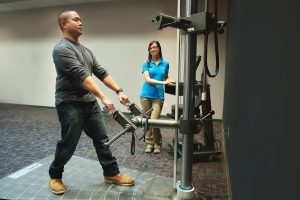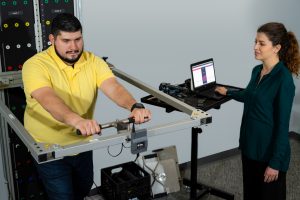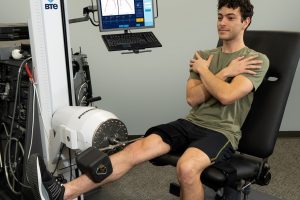
Why We Need The FCE-M for Military MSKIs
Treatment GuidelinesNon-combat MSKIs account for greater than 80% of military injuries. How can we better serve this population? The FCE-M is the first assessment that specifically addresses the military's many job demands.
Military personnel must complete intense training and maintain their best physical condition. As you know, a physically demanding job carries a heightened risk of musculoskeletal injury (MSKI). According to a recent study, non-combat MSKIs account for over 80% of military members’ injuries.1 In this article, we will take a broad look at military MSKIs and why the military needs a specialized Functional Capacity Evaluation (FCE).
Prevalence and Causes of Military MSKIs
According to a study protocol published in BMC Musculoskeletal Disorders, musculoskeletal disorders are the leading cause of disability for military personnel.1 Non-combat musculoskeletal injuries (MSKIs) account for over 80% of soldiers’ injuries and 65% of medically non-deployable active duty soldiers’ injuries.2
Based on information from the Army Injury Prevention fact sheets, lower extremity injuries are the most common type of injury. A few key occupational activities contribute significantly to the prevalence of military MSKIs. These activities include running and marching long distances with heavy loads and routinely lifting heavy objects. It follows that these activities contribute to lower extremity injuries and lower back pain.3
Although there is little we can do to change military occupational activity, we can still help these individuals prevent injuries. The first step is identifying risk.
Risk Identification
A qualitative, systematic literature review revealed several common risk factors contributing to military MSKIs. This literature spans two decades of studies from military service in the US and other countries. Twenty-one risk factors had moderate or strong evidence for increased risk of military MSKI.4 The risk factors were separated into two categories: modifiable and non-modifiable risks.
Modifiable Risks
The review revealed strong evidence linking these modifiable risks to increased likelihood of military MSKI:
- Smoking
- High amount of unit training
- Overweight, underweight, obese
- Higher body fat percentage
- Low physical fitness level
- Low or no participation in sports prior to military service
- Low levels of Vitamin D (moderate evidence)
Some of these risk factors are interrelated. For example, an MSKI could lead to weight gain, loss of overall fitness, and other conditions that make a person more susceptible to future injuries.
Non-modifiable Risks
Non-modifiable risk factors are, of course, not within our control. However, it is important to be aware of these factors so that we can plan accordingly. Important non-modifiable risks include medical history and sex. For example, having a previous MSKI puts service members (and most people) at higher risk.
Additionally, female service members are more likely to have an MSKI, according to the study. Women in the army have 1.3 times the risk of men when the data is not adjusted for aerobic fitness or other physical characteristics. Physical characteristics that may influence the higher risk rate for women include5:
- Differences in skeletal factors affecting bone strength
- Hormonal differences that affect tendon and ligament tautness
- Less muscle tissue as compared to men
- Higher percentage of fat as compared to men
Prevention and Interventions
As always, our goal is to prevent MSKIs and intervene when they occur. The best way to prevent injury is to mitigate risks ahead of time. Military guidelines make these suggestions to prevent an overuse injury:
- Strengthen calf muscles with toe raises
- Run on soft or even surfaces
- Maintain a healthy diet
- Lose weight
- Avoid exercises that bend the knee for an extended time6
The aforementioned literature review found that active-duty soldiers adhering standardized exercise program had reduced injury risk.2 As you can imagine, this is likely due to the benefits of overall strengthening and conditioning that prevent injury.
Although military service requires high levels of physical activity, several roles also require long periods of daily sitting at a desk. Just like civilians, military personnel working desk jobs are susceptible to desk-related MSKIs.
These injuries include carpal tunnel syndrome, low back pain, and shoulder / neck pain. An ergonomic assessment of the workspace with recommendations for modifications can support body structures while seated and during periods of physical movement.
The Need for Military MSKI Protocols
To date, there is no standardized treatment protocol that accounts for the physical demands of military job tasks. In the interim, a graded return to functional tasks should be used to return injured soldiers to full functional status7. An individualized program that supports functional, multiplane movements can improve muscle balance. Muscle balance decreases the risk of overuse injury caused by repetitive motion activities such as running.
In April 2022, BMC Musculoskeletal Disorders published a protocol for a study on military MSKIs. This future study would compare group training programs to individual physiotherapy with the goal of improving access to effective care. Researchers hope this work will “improve the health of military members by decreasing musculoskeletal pain and related functional limitations, as well as optimizing operational readiness.”1
FCE for Military MSKIs
Functional Capacity Evaluations (FCE) are high valuable assessments for determining a patient’s readiness to return to work. The military has especially demanding and specific job tasks, but historically, there was no standardized assessment for this population. Finally, in 2017 researchers developed a specialized FCE for military personnel.7
The Functional Capacity Evaluation-Military (FCE-M) is a detailed functional assessment that accounts for military occupational demands. The FCE-M has four categories and related subtasks, listed below:
- Weighted Tasks
- Core Lifts
- Drag / Push Military Task (i.e. dragging a training mannequin)
- Two-Hand Carry (carrying a weight with a minimum of 50 pounds with two hands)
- One-Hand Carry (carrying a weight with a minimum of 50 pounds with one hand)
- Positional Tolerance Tasks
- High Crawl Military Task
- Low Crawl Military Task
- Kneeling Task
- Mid-level Reach Task
- Elevated Reach Task
- Shooting Position Military Task
- Repetitive Tolerance Tasks
- Squatting Task
- Lateral Shooting Military Task
- Balance
- Clear Stairs Military Task
- Stair Climbing Task
- The Firearms Training System
During a study to assess the FCE-M’s usage, three military service members completed all categories of the FCE-M. The results were as follows7:
- Two members achieved a work-level classification of Heavy-Very Heavy
- One service member achieved a classification of Medium-Heavy.
FCE-M results can also inform a medical doctor’s recommendations to the military Medical Evaluation Board regarding a service member’s ability to complete their job duties.
Already doing FCEs? Learn how to improve your analysis in this article: Get Better Data from Your FCEs – Tips and Best Practices. Accurate data measurement is crucial to facilitating FCEs for any population. Learn how BTE’s clinical evaluation products can take your functional assessments to the next level. Systems like Prism and EvalTech provide everything you need to perform detailed, objective functional assessments in the clinic or on the jobsite.
Conclusion
The United States has an alarming prevalence of military MSKI, even when isolating non-combat injuries. This population needs a specialized approach to treatment and assessment. The FCE-M addresses military MSKIs in a way that’s specific to their unique needs and job tasks. A multi-tiered approach including risk identification, injury prevention, functional exercise, and a work readiness assessment can keep a service member healthy during their military career.
Tasha Perkins Holmes, MOT, OTR/L, BCP is an Occupational Therapist, telehealth expert, and freelance healthcare writer. She has created continuing education courses for allied health professionals as well as instructed future healthcare professionals. Writing is a means for her to share her knowledge about healthcare topics that are important to healthcare providers and consumers. Writing also provides a way for her to advocate for equitable access to healthcare and to increase the healthcare literacy of the public. Feel free to reach out on LinkedIn or Upwork.
References
- Dupuis, F., Perreault, K., Hébert, L.J. et al.Group-based exercise training programs for military members presenting musculoskeletal disorders – protocol for a pragmatic randomized controlled trial. BMC Musculoskelet Disord 23, 366 (2022). https://doi.org/10.1186/s12891-022-05317-6
- Molloy JM, Pendergrass TL, Lee IE, Hauret KG, Chervak MC, Rhon DI. Musculoskeletal Injuries and United States Army Readiness. Part II: Management Challenges and Risk Mitigation Initiatives. Mil Med. 2020 Sep 18;185(9-10):e1472-e1480. doi: 10.1093/milmed/usaa028. PMID: 32107561.
- https://phc.amedd.army.mil/topics/discond/ptsaip/Pages/Army-Injury-Prevention-Factsheets-and-Training-Products.aspx
- Sammito, S., Hadzic, V., Karakolis, T. et al.Risk factors for musculoskeletal injuries in the military: a qualitative systematic review of the literature from the past two decades and a new prioritizing injury model. Military Med Res 8, 66 (2021). https://doi.org/10.1186/s40779-021-00357-w
- Joseph M Molloy, PT, PhD, Timothy L Pendergrass, PT DSc ATC, Ian E Lee, PT, DSc, Michelle C Chervak, PhD, MPH, Keith G Hauret, MSPH MPT, Daniel I Rhon, PT, DSc, Musculoskeletal Injuries and United States Army Readiness Part I: Overview of Injuries and their Strategic Impact, Military Medicine, Volume 185, Issue 9-10, September-October 2020, Pages e1461–e1471, https://doi.org/10.1093/milmed/usaa027
- https://www.militaryonesource.mil/health-wellness/prevention-care/preventing-injuries-in-military-training/
- Cancio JM, Oliver RA, Yancosek KE. Functional Capacity Evaluation-Military: Program Description and Case Series. Mil Med. 2017 Jan;182(1):e1658-e1664. doi: 10.7205/MILMED-D-16-00072. PMID: 28051990. https://pubmed.ncbi.nlm.nih.gov/28051990/
- Functional rehabilitation criteria required for a safe return to active duty in military personnel following a musculoskeletal injury: A scoping review. Journal of Military, Veteran and Family Health. (n.d.). Retrieved December 14, 2022, from https://jmvfh.utpjournals.press/doi/abs/10.3138/jmvfh.3491
- Molloy JM, Pendergrass TL, Lee IE, Chervak MC, Hauret KG, Rhon DI. Musculoskeletal Injuries and United States Army Readiness Part I: Overview of Injuries and their Strategic Impact. Mil Med. 2020 Sep 18;185(9-10):e1461-e1471. doi: 10.1093/milmed/usaa027. PMID: 32175566.
- Cancio, Jill & Oliver, Robert & Yancosek, Kathleen. (2017). Functional Capacity Evaluation–Military: Program Description and Case Series. Military Medicine. 182. e1658-e1664. 10.7205/MILMED-D-16-00072.




